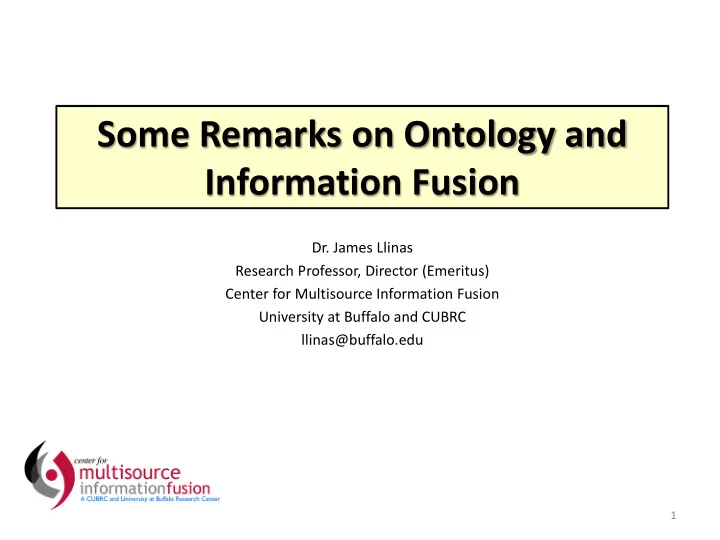

Some Remarks on Ontology and Information Fusion Dr. James Llinas Research Professor, Director (Emeritus) Center for Multisource Information Fusion University at Buffalo and CUBRC llinas@buffalo.edu 1
Roles for Ontologies in IF Processes/Systems • Reasonably reliable a priori Declarative Knowledge about some domain – In the face of domains for which reliable a priori Procedural (dynamic) Knowledge is hard to specify • “Weak Knowledge” problems • As such, they provide a framework that connects Entities and Relationships – Of fundamental concern for COIN, Ctr-Terrorism, Irregular Warfare re social structures and militarily- significant entity relations • The basic construct of a “Situation” or a “Threat” and thus Level 2, 3 Fusion estimation 2
Complexities in Distributed and Networked Systems • In modern Distributed/Networked Systems there are No single points of authority: These systems are collages of Legacy systems—Joint/Multiservice systems—Coalition systems • Nodal Ontologies for Fusion/Situational Estimation, and Communication-support Ontologies for Inter-Nodal Communications/Data-sharing (eg JC3IEDM) • Harmonizing NLP Operations and Ontologies within and across such systems • The issue of Uncertainty in Ontological specification : – Probabilistic and Non-Probabilistic Ontologies • Is there an Inescapable need for Semantic Mediation? – Mediator systems well-studied and developed* • Eg Gio Wiederhold (June 1, 1993). "Intelligent integration of information". ACM SIGMOD Record 22 (2) (This was a major DARPA program) 3
Semantic Complexity • Controlling Semantic Proliferation/Complexity: – Ontologies – Controlled Languages • Eg Battle Management Language – Eg Shade, U., et al, From Battle Management Language (BML) to Automatic Information Fusion, Chapter in Information Fusion and Geographic Information Systems, Lecture Notes in Geoinformation and Cartography,Popovich, V.V.; Claramunt, C.; Devogele, Th.; Schrenk, M.; Korolenko, K. (Eds.), 2011, Springer • Understanding complexity drivers in text • Eg McDonald, D.D., Partially Saturated Referents as a Source of Complexity in Semantic Interpretation, Proceedings of NLP Complexity Workshop: Syntactic and Semantic Complexity in Natural Language Processing Systems, 2000 • Measuring Semantic Complexity • Eg, Pollard, S and Biermann, A.W., A Measure of Semantic Complexity for Natural Language Systems (2000) Proceedings of NLP Complexity Workshop: Syntactic and Semantic Complexity in Natural Language Processing Systems, 2000 4
The Association Problem • The Ontologically-specified World is controllable—the Real Data World is not • While Ontologies can help in Fusion-based estimation and inferencing problems, the mechanics of exploitation will involve the associability of Real (uncontrolled) data to (controlled) Entities and Relations in the Ontologies – Semantic similarity, metrics, degree (“hops”), etc – Efficient algorithms—eg Cloud implementations – PhD-level research • There is also the issue of “Coverage”—in poorly- understood/known problems, how does one specify an Ontology that has “adequate” coverage? – Issue of negative information 5
Summary • Ontologies have a useful role in the design and development of Information Fusion systems • Questions regarding issues of: – Authoritative control of semantics in distributed systems • Acceptable, optimal methods for mediation – Complexity of semantics • Understanding, measuring, controlling – Association of semantic terms and complex, high- dimensional semantic structures • Seem to require further, continuing study to better define best ways to employ ontological information in complex, distributed, large-scale Information Fusion systems and applications 6
Recommend
More recommend